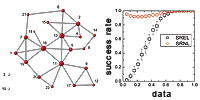Abstract
Evolutionary games model a common type of interactions in a variety of complex, networked, natural systems and social systems. Given such a system, uncovering the interacting structure of the underlying network is key to understanding its collective dynamics. Based on compressive sensing, we develop an efficient approach to reconstructing complex networks under game-based interactions from small amounts of data. The method is validated by using a variety of model networks and by conducting an actual experiment to reconstruct a social network. While most existing methods in this area assume oscillator networks that generate continuous-time data, our work successfully demonstrates that the extremely challenging problem of reverse engineering of complex networks can also be addressed even when the underlying dynamical processes are governed by realistic, evolutionary-game type of interactions in discrete time.
- Received 31 August 2011
DOI:https://doi.org/10.1103/PhysRevX.1.021021
This article is available under the terms of the Creative Commons Attribution 3.0 License. Further distribution of this work must maintain attribution to the author(s) and the published article’s title, journal citation, and DOI.
Published by the American Physical Society
Popular Summary
Complex networks and compressive sensing seem like two scientific topics that are far apart. Complex networks, composed of individual nodes and links, are mathematical- and physical- framework structures that distill and describe the essence and salient features of many complex interacting systems in nature and society. Neuronal networks in the human brain, protein networks in biological cells, and collaboration networks among scientists are some of the significant and interesting examples of complex networks. Compressive sensing is a technique recently developed in applied mathematics and signal processing to reconstruct a full picture and dynamics of an underlying system based on only a sparse amount of data. It has been widely used in many applications, including, for example, the analysis of large-scale sensor networks and digital-image processing in electrical engineering. In this paper, we bring compressive sensing to bear on the studies of complex networks and solve, for a class of social-interaction networks, one of the most challenging problems in complex-networks research: The problem of reconstructing the full node-link structures of interactions of the networks from sparse data on how the individual nodes act or function.
Interactions underlying a broad range of social-interaction networks fall under the theoretical models of evolutionary games, such as the so-called prisoner’s-dilemma games, which are caricatures of the emergence and the persistence of social cooperation among selfish individuals. In this paper, we first investigate theoretical models of networks of a number of known benchmark structures, where the individual parties (or nodes) interact with each other through a type of evolutionary game. Based only on small amounts of data collected on the individual players’ actions and results and, without using at all any prior knowledge of the network structures, our compressive-sensing-inspired approach successfully reconstructs the network structures faithfully.
To show that this success is not limited just to the theoretical models, we also conduct an actual social-interaction experiment involving 22 participants from Arizona State University, in which they play a version of prisoner’s-dilemma games. After collecting only a small amount of data on the participants’ strategies and payoffs, we apply our technique to analyze the data, assuming no knowledge of any existing social links between the participants. As in the cases of theoretical models, we fully uncover the network hosting those social links.
Looking ahead, we believe that our method can potentially be applied in other important contexts in science, for example, to construct gene-regulation networks from limited experimental data or digital-communication networks from information flow.



